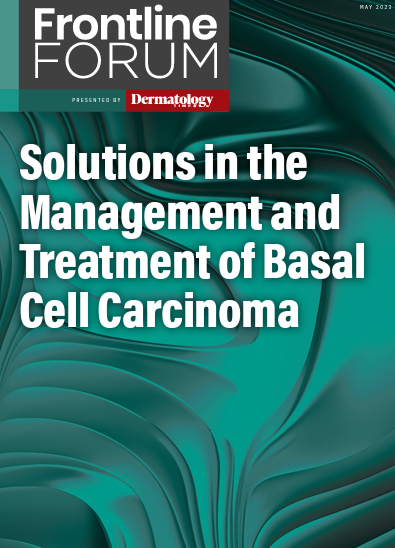- Case-Based Roundtable
- General Dermatology
- Eczema
- Chronic Hand Eczema
- Alopecia
- Aesthetics
- Vitiligo
- COVID-19
- Actinic Keratosis
- Precision Medicine and Biologics
- Rare Disease
- Wound Care
- Rosacea
- Psoriasis
- Psoriatic Arthritis
- Atopic Dermatitis
- Melasma
- NP and PA
- Skin Cancer
- Hidradenitis Suppurativa
- Drug Watch
- Pigmentary Disorders
- Acne
- Pediatric Dermatology
- Practice Management
- Prurigo Nodularis
- Buy-and-Bill
Publication
Article
Dermatology Times
Frontline Forum Part 4: Solutions in the Management and Treatment of Basal Cell Carcinoma
Author(s):
In part 4 of this Frontline Forum series, John M. Strasswimmer, MD, PhD; Andrew H. Weinstein, MD; Neal Bhatia, MD; Laura Ferris, MD; and Aaron S. Farberg, MD, discuss solutions for managing and treating patients with basal cell carcinoma.
Clinical Decision-Making
To better understand the many factors that influence treatment, the panel discussed a case example of an older patient with “little scabby bleeding thing on the nose.” Strasswimmer asked his colleagues, “What would be your thought process here, your stepwise algorithm?”
Bhatia’s actions would depend on the patient’s age, and said his first instinct is Mohs. However, if the patient is older (ie, in their 80s) when resolving the issue is more important than the repair, a worthwhile conservative approach is would be electrodesiccation and curettage and possibly adjunctively treat with imiquimod. If the patient was in their 50s, he would prefer to have a good surgical repair.
Examining the pathology is also an important part of deciding treatment, Ferris said, and sometimes a dermatopathologist and Mohs surgeon can be of assistance in really figuring it out. “I can say that’s probably a basal cell but is it nodular? Is it infiltrative?” she said. “I think sometimes starting with Mohs is important because you only get a little bit when you do your biopsy so you don’t know—you don’t see the perineural invasion that’s there. Maybe what you biopsied was nodular, but you didn’t see that micro-nodular component.”
The panel also said having conversations with oncologist colleagues—doing so early on—is important, as is talking with the patient.
“It’s a collaborative approach—between you and the patient, Farberg said. “I really like the way Dr Bhatia described how he would approach this patient, because he gives some of the best lectures about having various tools in your doctor’s toolkit. One patient may be Mohs, one patient may be a topical cream, one patient may be immunotherapy. You really need to evaluate the entire patient.”
The logistics of treatment may also play a role for patients, Farberg added. “That’s the best part about medicine is every patient is different and will have their own thoughts and opinions, and risk tolerance, and adverse events tolerance,” he said. “I look at this patient and think, Perhaps yes, we could do surgery, but it may impact their breathing. And I don’t know how many times a person breathes every day, every year, but I know it’s a lot. And if you’re impacting something like breathing, it is going to have an impact on their life. Whereas I could consider an immunotherapy such as [cemiplimab] or perhaps even radiation. Or even a hedgehog inhibitor, too.”
If this a recurrence, then that might sway Weinstein’s treatment strategy. “There are some patients who have been through the cancer wars, and they say to you just simply, doc, I cannot have another surgery. What do you think would be appropriate for this?’” he said. “It doesn’t take very much time to say that there’s an infusion for this and there’s a pill.”
This may also be true for patients that have dealt with chemotherapy and radiation, as well as all the negative adverse effects associated with it. “You feel for them and you feel for their family,” he said. “That’s who you have to really think of these alternative therapies, hedgehog and [immune] checkpoint inhibitors. And I think in many ways, the hedgehogs are much more difficult to take than people think.”
Ferris and Weinstein bring in palliative care as an option when considering treatment. ”Sometimes there are these huge tumors, and you just want to make it not bleed as much,” Ferris said.
Looking to the Future
During concluding thoughts, the panel noted that BCC may come to be seen as a disease of the immune system, where there is a failure to remove basal cells, and immune therapy may be developed more as a future therapy. “Immune therapy is a new paradigm for treating BCC. We’ve had imiquimod for years that we know works great for superficial type of things, so we know that kickstarting the immune system can really help, as well,” Strasswimmer said.
Farberg drummed up conversation around cemiplimab (Libtayo), which was studied a decade ago, and many are now understanding its potential value. Cemiplimab is an option for many patients, even those who are not candidates for HHI therapy.
“If we can space things out with every 3-week infusions rather than daily pills, and those adverse events are more localized to immune responses or infusion reactions, we could probably have a better outcome managing them,” Bhatia said.
When the conversation shifted back to intermittent physician-administered therapy, Bhatia shared that patients think of intravenous drugs like biologics: they associate it with being very sick, and they do not want that label. He noted the big disconnect in infusion therapy and the importance of communicating the treatment benefits.
“We’re so spoiled in dermatology with our 99% to 100% cure rates, so when you have a trial that shows something can work in a certain population of patients, [such as cemiplimab for advanced BCC], you can infer around the efficacy,” Weinstein said.
The panelists noted more research will ultimately lead to better results for patients. “It’s so important as dermatologists [to not only] understand the pathophysiology of [BCC] but [to] also [understand] the treatment options,” Farberg said. “I’m so excited for the future and pipeline treatments to come.”






